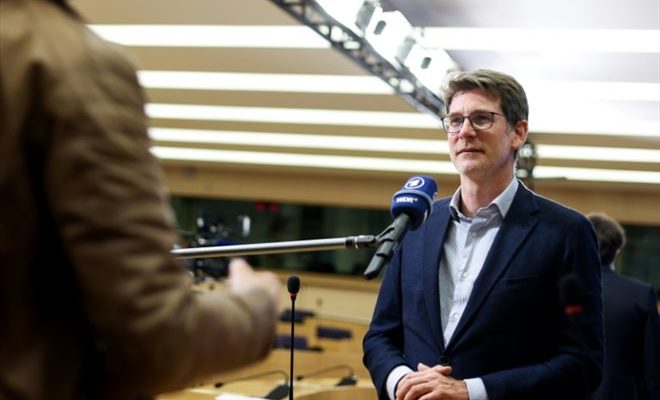The President of the European Commission Ursula von der Leyen, at the European Parliament in Brussels, March 29, 2023 (AFP / Kenzo TRIBOUILLARD)
EU member states and MEPs agreed on Thursday to almost double the share of renewables in the energy mix by 2030, a key component of the ambitious European climate plan.
The approved text consecrates biomass (wood burned to produce energy) as green energy, to the chagrin of environmental NGOs worried about the impact on forests, and takes into account the role of nuclear power to produce carbon-free hydrogen – -subject which sharply divided the Twenty-Seven.
The agreement, reached at dawn after fifteen hours of final talks, sets the binding target of 42.5% of renewables in European consumption by 2030, a virtual doubling of the current level of about 22% (19% in France).
This target is halfway between the 45% demanded by the European Commission and MEPs, and the 40% demanded by the States. This is a clear increase from the current EU target for 2030 (32%).
-Simplified procedures-
The text simplifies and speeds up the authorization procedures for renewable energy infrastructures, with the establishment of dedicated territories where the regulations will be drastically relaxed.
Deployment of renewables will be presumed to be ‘in the overriding public interest’, restricting the grounds for legal objections to installations.

Wind turbines in Villar de los Navarros, in the region of Zaragoza, Spain on April 5, 2022 (AFP/CESAR MANSO)
The EU plans 49% renewables in the energy consumption of buildings, with a progressive and binding greening trajectory for heating and cooling via specific national targets.
In transport, the States will have by 2030 either to reduce the intensity of greenhouse gases by 14.5% thanks to the use of renewables, or to reach at least 29% of renewables in the final energy consumption of the sector. .
The agreement sets a binding sub-target of 5.5% for “advanced biofuels” (derived from non-food feedstocks) and “renewable fuels of non-biological origin” (renewable hydrogen, synthetic fuels based on hydrogen) in renewables dedicated to transport.
– “Specific status” of nuclear power –
Industry’s use of renewables will have to increase by 1.6% per year. In each country, the share of renewable hydrogen in the hydrogen used by industry must reach 42% by 2030 and 60% by 2035.
However, the Swedish presidency of the EU, which was negotiating on behalf of the States, obtained a relaxation of the objective for countries with a large nuclear fleet, able to produce carbon-free hydrogen thanks to the atom. civil.
The question tore the Twenty-Seven: France and its allies demanded equal treatment between renewable hydrogen and “low-carbon” – a red line for several countries (Germany, Austria, Luxembourg, Spain …), which refused to encourage nuclear power in a text devoted to green energies at the risk, according to them, of slowing down investment in renewables.

MEP Pascal Canfin (Renew, Liberals), chairman of the Environment parliamentary committee, in Brussels on April 21, 2021 (AFP/Archives/Kenzo TRIBOUILLARD)
Finally, the agreement reached provides that the 2030 target for renewable hydrogen may be reduced by 20% for Member States where the share of fossil hydrogen in the country’s consumption is less than 23%.
“France will not be obliged to build renewables to make hydrogen for industry and transport but will also be able to use nuclear power (to meet the objective). It was an absolute condition for France to support the final agreement”, observed French MEP Pascal Canfin (Renew, Liberals), chairman of the Parliamentary Environment Committee.
However, the text recognizes nuclear “a specific status, neither green nor fossil”, he insisted. What comfort the States refusing an equivalence between atom and green energies.
-Biomass-
The agreement maintains the “renewable” status of bioenergy, but “strengthens the sustainability criteria for the use of biomass” (wood that is burned), the sources of which are prioritized “according to their economic and environmental added value. “.
For MEP Markus Pieper (EPP, right), the text enshrines “100% green” biomass. “Its use is better framed even if the Parliament wanted to go further”, tempers Mr. Canfin.
Fiercely defended by Scandinavian countries, the practice is denounced by environmental NGOs, worried about the impact on forests as carbon sinks and biodiversity refuges.
“Energy production is by far the first use of wood in Europe, more than half of the wood harvest burned, a proportion that is constantly increasing,” said Martin Pigeon, of the NGO Fern, indignantly. lambasting a law that “will continue to reward energy companies burning millions of trees.”
© 2023 AFP
Did you like this article ? Share it with your friends with the buttons below.




